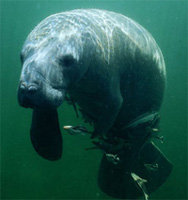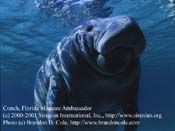West Indian Manatee Research Links
Belize
- A World Model
- Belize Overview
- CZMA&I
- Earthwatch
- WildTracks
- Wildlife Trust
- Oceanic Society
- Gales Point
Brazil
Mexico
Other Caribbean
Florida/USA
 The West Indian manatee, Trichechus manatus,
is a species distinct from the Amazonian manatee, T. inunguis, and the West African manatee, T. senegalensis. Domning and Hayek
(1986 Marine Mammal Science 2(2):87-144) and Hatt (1934 Natural History 66:533-566) agree that the West Indian manatee can
be divided into 2 subspecies: (1) the Florida manatee (T. m. latirostris) and (2) the Antillean or Caribbean manatee (T. m. manatus).
However, recent genetic (mtDNA) research suggests that the West Indian manatee actually falls out into 3 groups, which are more or less
geographically distributed as: (1) Florida and the Greater Antilles; (2) Central and Northern South America; and (3) Northeastern South
America (Garcia-Rodriguez 1998 Molecular Ecology 7:1137-1149; Vianna et al. in press Molecular Ecology). Whether these
3 groups should be classified as 3 subspecies is currently debated among sirenian specialists. This recent research also discovered
West Indian-Amazonian manatee hybrids near the mouth of the Amazonian River!
The West Indian manatee, Trichechus manatus,
is a species distinct from the Amazonian manatee, T. inunguis, and the West African manatee, T. senegalensis. Domning and Hayek
(1986 Marine Mammal Science 2(2):87-144) and Hatt (1934 Natural History 66:533-566) agree that the West Indian manatee can
be divided into 2 subspecies: (1) the Florida manatee (T. m. latirostris) and (2) the Antillean or Caribbean manatee (T. m. manatus).
However, recent genetic (mtDNA) research suggests that the West Indian manatee actually falls out into 3 groups, which are more or less
geographically distributed as: (1) Florida and the Greater Antilles; (2) Central and Northern South America; and (3) Northeastern South
America (Garcia-Rodriguez 1998 Molecular Ecology 7:1137-1149; Vianna et al. in press Molecular Ecology). Whether these
3 groups should be classified as 3 subspecies is currently debated among sirenian specialists. This recent research also discovered
West Indian-Amazonian manatee hybrids near the mouth of the Amazonian River!Photo of Antillean manatee in Belize - 1999 (c) Leszek Karczmarski, Sirenian International, Inc.
Florida manatees inhabit the southeastern United States, primarily in Florida, but they are commonly sighted in Georgia, too. During the warmer summer months, Florida manatees have been sighted as far north as Rhode Island and as far west as Texas! Recent mitochondrial DNA studies suggest that Florida manatees may also inhabit waters around Puerto Rico and the Dominican Republic. Chessie, possibly the most famous Florida manatee who traveled to Rhode Island in 1995, may migrate from Miami to the Chesapeake Bay every year. Gina, another famous Florida manatee has been sighted from Crystal River to the Bahamas! And Sweet Pea, who was once "rescued" from the Houston (Texas) shipping channel, was tracked as she explored Florida's east AND west coast!
Antillean manatees inhabit riverine and coastal systems throughout the Wider Caribbean region and are recognized as a priority species of regional concern, protected by national, and international laws (Lefebvre et al. 2001). The status of Antillean manatees was assessed as �vulnerable� by the IUCN Species Survival Commission�s Sirenia Specialist Group (SSC/SSG) in 1996 (VU A2d ver.2.3 1994). Relatively little is known about this subspecies...compared to what is known about the Florida manatee. Most general statements about manatees are based on research done in Florida and should not necessarily be attributed to Antillean manatees.
Florida and Antillean manatees are sighted in salt, fresh, and brackish waters where they feed on marine, estuarine, and fresh water vegetation. Studies in Florida suggest that Florida manatees must have some access to fresh water for proper osmoregulation.
 Conch, our Florida Manatee Ambassador
(scientific name Trichechus manatus latirostris), is named after
the beautiful conch snail seashell commonly associated with Florida. He
represents a subspecies of the West Indian manatee, the largest of
all sirenians. Florida manatees inhabit the most northern limit of
sirenian habitat. They are found in Florida year-round and during the
warmer summer months, some Florida manatees travel north up the east coast
of the United States to Georgia, South Carolina, and North Carolina.
Rarely, they are sighted in the Chesapeake Bay and in 1995 one went all
the way to Rhode Island! Over three decades of research by universities,
governmental agencies, and NGOs, have contributed to our understanding of
Florida manatee ecology and behavior, which is more than we know about any
other species. They are found in fresh water rivers, in estuaries, and in
the coastal waters of the Gulf of Mexico and the Atlantic Ocean. Females
usually have their first calf when they are about 4 years old. Normally
they only have one calf every 2-5 years, but there are rare occurrences of
twins. The family unit consists of mother and calf, which remain together
for up to 2 years. Males aggregate in mating herds around a female when
she is ready to conceive, but contribute no parental care to the calf.
Florida manatees may live to be greater than 60 years old in the wild. The
biggest single threat to Florida manatees is death from collisions with
recreational watercraft.
Conch, our Florida Manatee Ambassador
(scientific name Trichechus manatus latirostris), is named after
the beautiful conch snail seashell commonly associated with Florida. He
represents a subspecies of the West Indian manatee, the largest of
all sirenians. Florida manatees inhabit the most northern limit of
sirenian habitat. They are found in Florida year-round and during the
warmer summer months, some Florida manatees travel north up the east coast
of the United States to Georgia, South Carolina, and North Carolina.
Rarely, they are sighted in the Chesapeake Bay and in 1995 one went all
the way to Rhode Island! Over three decades of research by universities,
governmental agencies, and NGOs, have contributed to our understanding of
Florida manatee ecology and behavior, which is more than we know about any
other species. They are found in fresh water rivers, in estuaries, and in
the coastal waters of the Gulf of Mexico and the Atlantic Ocean. Females
usually have their first calf when they are about 4 years old. Normally
they only have one calf every 2-5 years, but there are rare occurrences of
twins. The family unit consists of mother and calf, which remain together
for up to 2 years. Males aggregate in mating herds around a female when
she is ready to conceive, but contribute no parental care to the calf.
Florida manatees may live to be greater than 60 years old in the wild. The
biggest single threat to Florida manatees is death from collisions with
recreational watercraft.
 Maya, our Antillean Manatee Ambassador
(scientific name Trichechus manatus manatus), is named after the
Mayan Indians whose ancient cities are found throughout Central America.
She represents the other subspecies of the West Indian manatee and
is sometimes referred to as a Caribbean manatee. Antillean manatees are
sparsely distributed throughout the Caribbean and the NW Atlantic Ocean,
from Mexico, east to the Antilles, and south to Brazil. They are found in
French Guiana, Surinam, Guyana, Trinidad, Venezuela, Colombia, Panama,
Costa Rica, Nicaragua, Honduras, Guatemala, Belize, Mexico, Cuba, Haiti,
Dominican Republic, Jamaica, and Puerto Rico. Historically Antillean
manatees were hunted by local natives and sold to European explorers for
food. Today they are threatened by loss of habitat, poaching, entanglement
with fishing gear, and increased boating activity. Several of Sirenian
International's scientists study Antillean manatees in Belize, which may
be the last stronghold for the subspecies. Funds for research, education,
and conservation projects are desperately needed in other Central American
nations.
Maya, our Antillean Manatee Ambassador
(scientific name Trichechus manatus manatus), is named after the
Mayan Indians whose ancient cities are found throughout Central America.
She represents the other subspecies of the West Indian manatee and
is sometimes referred to as a Caribbean manatee. Antillean manatees are
sparsely distributed throughout the Caribbean and the NW Atlantic Ocean,
from Mexico, east to the Antilles, and south to Brazil. They are found in
French Guiana, Surinam, Guyana, Trinidad, Venezuela, Colombia, Panama,
Costa Rica, Nicaragua, Honduras, Guatemala, Belize, Mexico, Cuba, Haiti,
Dominican Republic, Jamaica, and Puerto Rico. Historically Antillean
manatees were hunted by local natives and sold to European explorers for
food. Today they are threatened by loss of habitat, poaching, entanglement
with fishing gear, and increased boating activity. Several of Sirenian
International's scientists study Antillean manatees in Belize, which may
be the last stronghold for the subspecies. Funds for research, education,
and conservation projects are desperately needed in other Central American
nations.
Orphans: Participating members are eligible to apply for funds to support their manatee orphan rehabilitation projects, however, Sirenian International is NOT directly supporting the orphans listed below -- these pages are provided for information only and contribute to our research, education, and conservation goals. Click on a name below to learn more about orphaned animals around the world. Contact information is provided on each of the following pages for direct support to the rehabilitation project.
